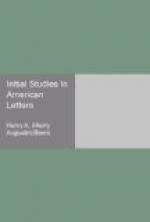“From the desert I come to thee
On a stallion shod with fire;
And the winds are left behind
In the speed of my desire.
Under thy window I stand,
And the midnight hears my
cry;
I love thee, I love but thee,
With a love that shall not
die.”
The dangerous quickness with which he caught the manner of other poets made him an admirable parodist and translator. His Echo Club, 1876, contains some of the best travesties in the tongue, and his great translation of Goethe’s Faust, 1870-71—with its wonderfully close reproduction of the original meters—is one of the glories of American literature. All in all, Taylor may unhesitatingly be put first among our poets of the second generation—the generation succeeding that of Longfellow and Lowell—although the lack in him of original genius self-determined to a peculiar sphere, or the want of an inward fixity and concentration to resist the rich tumult of outward impressions, has made him less significant in the history of our literary thought than some other writers less generously endowed.
Taylor’s novels had the qualities of his verse. They were profuse, eloquent, and faulty. John Godfrey’s Fortune, 1864, gave a picture of bohemian life in New York. Hannah Thurston, 1863, and the Story of Kennett; 1866, introduced many incidents and persons from the old Quaker life of rural Pennsylvania, as Taylor remembered it in his boyhood. The former was like Hawthorne’s Blithedale Romance, a satire on fanatics and reformers, and its heroine is a nobly conceived character, though drawn with some exaggeration. The Story of Kennett, which is largely autobiographic, has a greater freshness and reality than the others, and is full of personal recollections. In these novels, as in his short stories, Taylor’s pictorial skill is greater on the whole than his power of creating characters or inventing plots.




